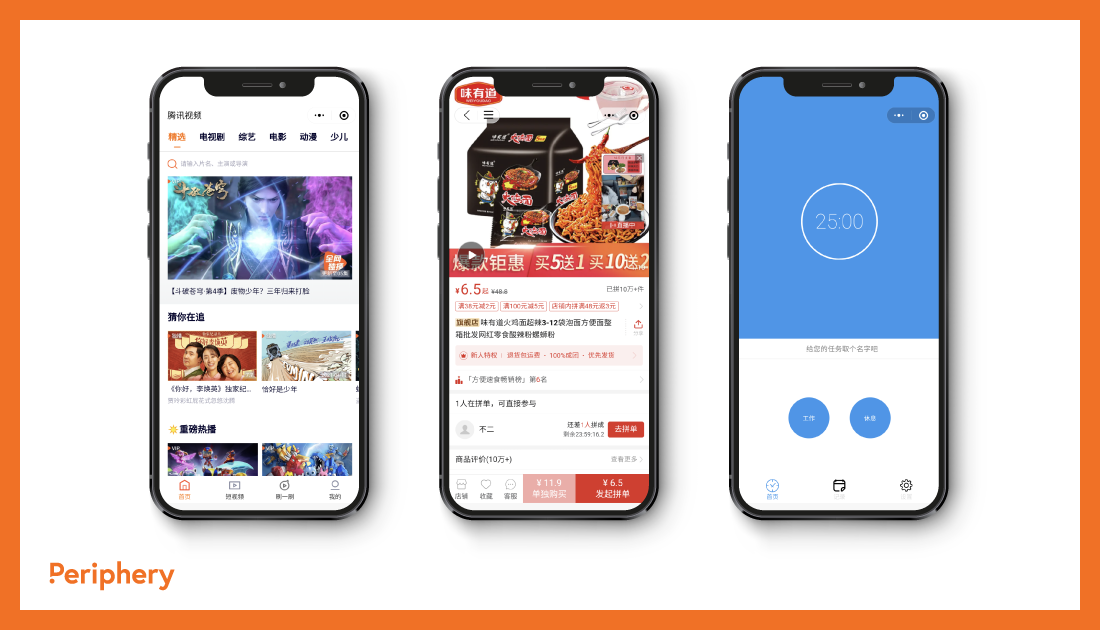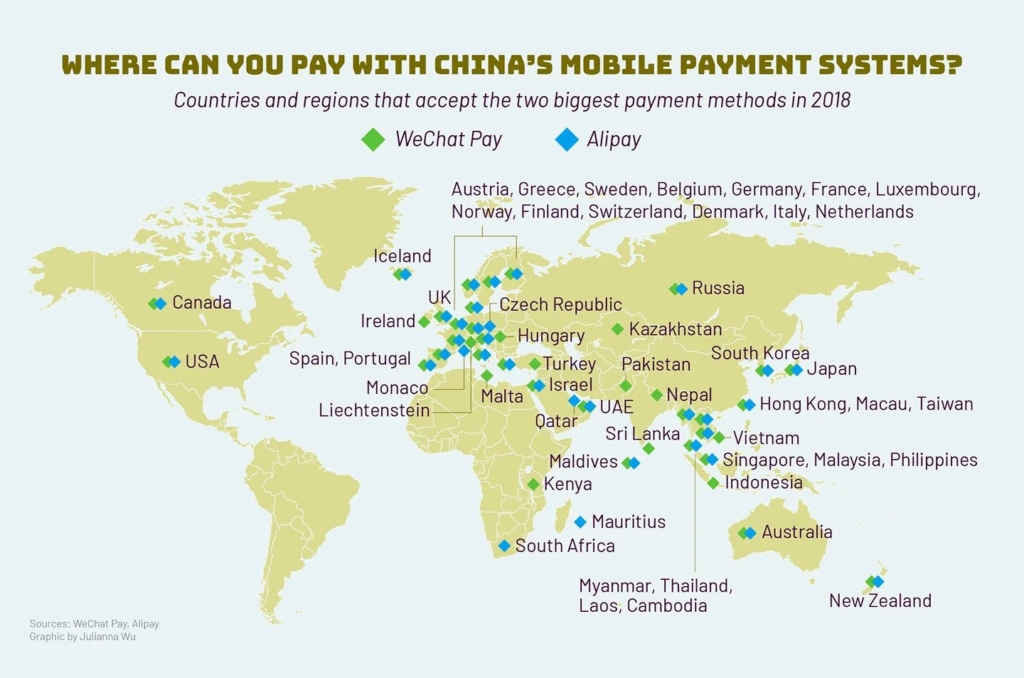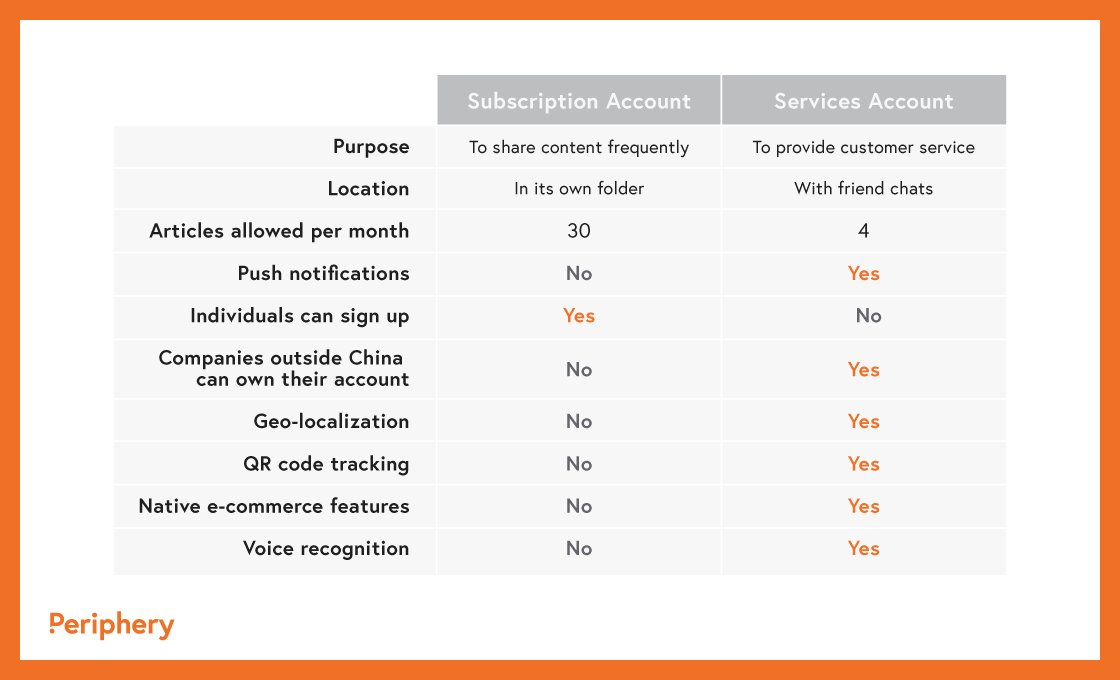WeChat, also known as Weixin in China, is a staple in Chinese social media. WeChat has seen explosive growth since its inception in 2011. To put just how explosive into perspective — of China’s 1.4 billion people, WeChat currently has 1.2 billion active monthly users. That’s 15% of the world’s population.

What began as a simple messaging application has quickly become a one-stop shop for everything from social media to online shopping to personal banking. As a comparison, WeChat can be seen as a conglomeration of Facebook, WhatsApp, Amazon, PayPal, and Apple Wallet into just one app. Some of the things users can do on WeChat include:
- Picture sharing
- Paying phone and electricity bills
- Ordering food
- Chatting with friends and family
- Playing games
- Investing money into a wealth-management plan
- And much more

What WeChat has done successfully in comparison with its other social media counterparts is its ability to develop a devoted community. This community of users is glued to WeChat as it provides a way for people to connect not only to other people but also to businesses. This can be seen through WeChat’s development of an e-commerce component, WeChat Pay, which has seen immense success.
In 2013, WeChat released WeChat Pay, an app-within-app that allowed peer-to-peer (P2P) transfers. Essentially, WeChat Pay is a “Digital Wallet” that functions as a mini-app within WeChat and links to a user’s active social media account. The Digital Wallet can take money directly from users’ personal bank accounts, allowing the users to complete all their personal banking and online shopping without ever having to leave the app.
Although it came late to the game compared to other third-party payment systems like Alipay, WeChat Pay quickly rose to competitor status, expanding its operations to include everything from bill payments to groceries. By 2019, it had claimed 40% of the market share for online transactions.

What this Means for Canadian Businesses
Introducing the mobile-payment infrastructure to support WeChat Pay and Alibaba in Canada offers the potential for Canadian businesses to gain a much larger Chinese tourist market.
As of June 2017, Toronto-based OTT Financial Inc. has already begun working with Tencent and Alibaba to introduce their mobile-payment infrastructure in Canada. Chinese tourists will be able to make payments in RMB, which will then be translated to CAD using the spot currency exchange.
Let’s Get Started: Getting Verified and Choosing a WeChat Official Account
So you want to start marketing to consumers using WeChat? The first thing you’ll need to do is set up an officially verified WeChat account. An Official Account will allow your brand to be seen both inside and outside mainland China, effectively jumping the infamous firewall which blocks social networks like Facebook, Instagram, Twitter and even Google in Mainland China.
Prior to 2018, registering for an Official Account was only available for Chinese-owned enterprises, or accounts registered by marketing agencies or third-party Chinese intermediaries.
However, it comes with a price, and is not nearly as simple as creating a Facebook company page. On top of the annual $99USD verification fee, Tencent requires many verification documents to be submitted in order for the Official Account to be owned by an overseas business. These can include but are not limited to:
- Certificate of incorporation
- Business license
- WeChat account manager’s driver’s license, phone bill, and business card
- Certification of brand, trademark, or Power of Attorney of brand
- Notice of Articles
- Registration forms
Once submitted, the information is then passed to The Cyberspace Administration of China (CAC) who directs cybersecurity and internet content regulation. Approval happens on a case-by-case basis and can depend on which type of entity you are registering. For example, in our experience, a real estate development company is generally smooth sailing, but a retail business or non-profit might need to submit additional documents for verification.
It can be a lengthy process, but recently, Tencent has sped up the process so each step has a 1-3 day turnaround time. It’s important to keep in mind that Tencent can change and update this process as they see fit.
It also doesn’t help that this process is only available in Chinese language. It helps to have a Chinese-speaking representative to manage this process for you. Alternatively, Periphery Digital partners with Tencent to handle countless end-to-end WeChat Official Account registrations for our clients — we can help get yours up and running too. Contact us to learn more.
Choosing Between Subscription and Service Accounts
There are actually three types of official WeChat accounts: subscription, service, and enterprise. However, only subscription and service accounts are used for marketing purposes; enterprise accounts are primarily for internal business management. Both subscription and service accounts appear in the main feed of WeChat, and have limited amounts of messages they can send out in a given period of time. At its core, subscription accounts are for those that want to push content regularly while service accounts are used to access more features such as customization of ones’ page or providing customers with the ability to pay through the application.

Subscription accounts can send out one ‘newsletter’ every day (with a maximum of eight ‘articles’ each time a message is sent out). While the subscription account has the ability to send more messages at a high frequency, it has one major drawback: content sent through a subscription account must be accessed through a separate “subscription” folder. Because all content from any subscription account will be sent to this folder it can be seen as high clutter and has lower potential engagement. Subscription accounts are often best for media publications or blogs.
Like the name suggests, a service account is for businesses that are looking to provide a service through their account. With the ability to customize your account and provide features like payments, service accounts are essentially micro websites within the application and a possible point-of-sale for your customers. Service accounts are displayed alongside a user’s personal contacts. Messaging through a service account can feel more direct as messages sent will go directly to your followers’ feed. The major drawback of this is that service accounts are limited to 1 ‘newsletter’ per week (each with up to eight articles). A service account is recommended for most brands, but is more difficult to acquire compared to subscription accounts.

Advertising with WeChat
In addition to having an official, verified account, WeChat also has several different advertising options available.
- Moment advertising
- Banner advertising
- Key opinion leader (KOL) advertising
Moment Advertising
Moment advertising is usually the most familiar to Western marketing companies. These ads appear on the main feed of WeChat — much like Facebook timeline ads. Essentially, you are buying permission from WeChat to post sponsored content on its users’ main feeds. One thing to keep in mind — users can only see one Moment ad per day.
There are many restrictions on what you can and can’t post on users’ WeChat feeds, much like there are on other platforms like Facebook or Google. Some things that are not allowed include:
- Absolute terms like, ‘first’, ‘best’, ‘top’, ‘number one’, ‘premium’, etc
- On a similar note, scarcity tactics are not allowed: ‘rare’, ‘only a few left’, etc
- Misleading or deceptive ads
- Undermining competitors
- Unauthorized third-party images or logos
- Discriminatory language
Once you are approved to post moment ads, you will be able to include your brand name and profile picture, a short description (up to 40 characters), a link to a webpage hosted on one of Tencent’s servers, and up to 6 pictures or 6 15-second videos.
Additionally, you will be able to target users based on their location, phone network, gender and age. What’s not to love?

Banner Advertising
Banner advertising on WeChat is very similar to banner ads on familiar platforms like Google and Facebook. They are located at the bottom of articles written by Official Accounts, and may include a link to a page with more information or a call-to-action.
The ads are generally very simple, requiring only basic design skills. It is also possible to download premade banner templates or hire a reasonably-priced designer. On top of that, the ads are performance-based, so advertisers can track the relative success of their ads before pouring a ton of money into their campaigns. Consumers will also be more exposed to the company’s brand, helping to increase overall brand recognition using a multi-sensory, text and picture banner format.
One downside to advertising with banners is that they can be quite pricey. Furthermore, getting permission to advertise using banners requires foreign companies to prove their products are legitimate. This requires a time-consuming process of approving your brand with the Chinese government.
However, banner ads are still a great advertising medium for businesses, large and small, looking to target specific demographics and track the success of their ad campaigns using the performance-based advertising template.

Key Opinion Leader Advertising (KOL)
Key opinion leader advertising involves partnering your brand with an already-established social media influencer. WeChat allows KOLs to post longer, narrative-style, articles promoting different brands and products. These KOL advertisements usually come in four formats:
- Advertorials/product placement
- Product reviews
- Interactive campaigns with KOL support
- Combined sponsored articles and direct sales
Advertorials
These types of ads are great because it generally isn’t immediately obvious that these are sponsored posts. Advertorials can also be seen on popular media publications’ Official Accounts as well as individual KOLs. They will generally have a compelling headline, and begin with a topic that doesn’t involve the product it is ultimately promoting, but is related to it. They are filled with colourful, interactive design elements representative of the product or service. Only at the end of the advertorial does the writer mention the product or service and include a call-to-action.
Product Reviews
You can work with KOLs to review your product or service by compensating them for a review, or sending them a sample for free. If you choose the latter option, be sure to select a KOL known for product reviews, and who has a good reputation for honest reviews. You don’t want your reputation tainted by an ingenuine review.
Interactive Campaigns
These include livestreams, contests, giveaways, and other creative ways KOLs can directly involve their audience with your product. We had great success partnering with a media vendor for a livestream featuring KOLs for a giveaway sponsored by our client Telus — it resulted in 11k people watching and a 167% engagement rate.

As you can see, WeChat presents a key opportunity for Canadian businesses to reach the Chinese market where they spend their time. However, it can be difficult to navigate a new social network, especially if it’s not in your native language! A partner specialized in WeChat marketing like Periphery Digital can help with all aspects of your WeChat strategy to get you the best return on investment. Contact us today to learn more about what we can do for your organization.



